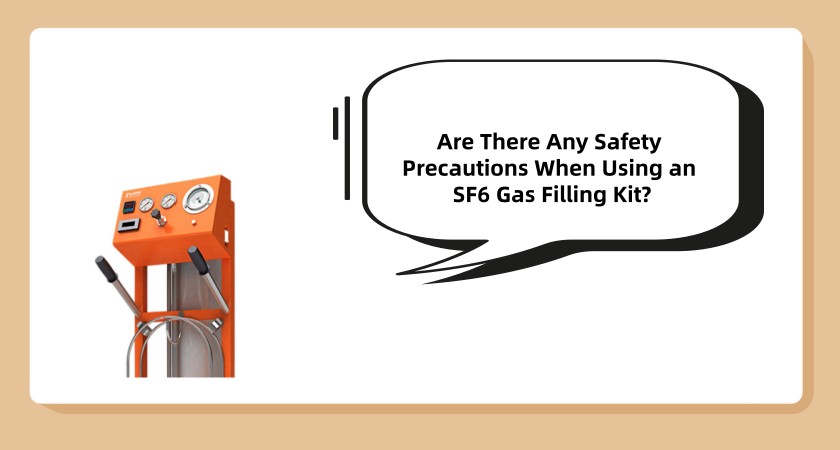Yes, using an SF6 gas filling kit requires strict safety precautions to protect personnel from toxic exposure, pressure hazards, and environmental risks—critical given SF6’s inert nature, toxic decomposition byproducts, and high global warming potential (GWP). Below is a comprehensive breakdown of mandatory safety measures, aligned with international standards (IEC 60376, OSHA, CE) .
1. Pre-Operation Safety Checks
Inspect the SF6 filling kit for integrity: Check hoses, valves, fittings, and pressure gauges for cracks, corrosion, or leaks. Replace worn seals (e.g., O-rings) and damaged components—even minor leaks can lead to SF6 accumulation or gas loss.
Verify calibration of instruments: Ensure pressure gauges, flow meters, and SF6 gas detectors are calibrated within the past 12 months (per IEC 61508). Uncalibrated tools risk overfilling or underdetecting leaks.
Confirm compatibility with SF6: Use only SF6 gas filling kits rated for SF6 service—avoid generic gas handling equipment, as SF6’s density and chemical properties require specialized materials (e.g., brass, PTFE seals) to prevent reactions.
Check the target equipment’s condition: Ensure the SF6-containing device (GIS, circuit breaker) is depressurized, isolated from live systems (lockout/tagout, LOTO), and free of prior contamination (e.g., moisture, oil).
2. Personal Protective Equipment (PPE) Requirements
Respiratory protection: Wear a NIOSH-approved respirator (Type C or higher) with SF6-specific cartridges. SF6 displaces oxygen in confined spaces, and decomposition byproducts (SO2, HF) are toxic—respirators prevent inhalation hazards.
Skin and eye protection: Use chemical-resistant gloves (neoprene or nitrile) and safety goggles with face shields. SF6 itself is non-irritating, but cold gas expansion during filling can cause frostbite, and corrosive byproducts may splash.
Protective clothing: Wear flame-retardant (FR) coveralls or lab coats to shield against accidental spills or contact with cold components (e.g., chilled hoses from rapid gas expansion).
3. Operational Safety Protocols
Work in well-ventilated areas: SF6 is heavier than air and accumulates in low-lying spaces (e.g., basements, pits). Ensure natural or mechanical ventilation (4–6 air changes per hour) to prevent oxygen depletion.
Control filling pressure and flow: Never exceed the target equipment’s maximum operating pressure (specified by the manufacturer). Use a pressure regulator to limit flow rates (≤5 bar/min) and avoid rapid filling, which can generate static electricity or damage seals.
Avoid mixing gases: SF6 kits must be dedicated to SF6 only—never use them for other gases (e.g., N2, CO2). Cross-contamination reduces SF6 purity and risks equipment failure.
Monitor for leaks in real time: Use a portable SF6 leak detector (sensitivity ≤1 ppm) during filling. Scan connections, hoses, and the target equipment’s valves—stop immediately if leaks are detected.
Prevent static electricity: Ground the SF6 gas filling kit, hoses, and target equipment using a conductive cable. Static discharge can ignite any residual flammable contaminants (e.g., oil vapor) in the system.
4. Confined Space Safety (If Applicable)
If filling SF6 in confined spaces (e.g., underground substations), assign a standby operator outside the space to monitor gas levels and assist in emergencies.
Use a multi-gas detector to measure SF6 concentration, oxygen levels (≥19.5%), and toxic byproducts—evacuate if SF6 exceeds 1000 ppm (8-hour TWA limit per OSHA) or oxygen drops below safe thresholds.
Establish a clear communication channel (radio or hand signals) between the on-site operator and standby personnel.
5. Post-Operation Safety Steps
Purge the SF6 gas filling kit: Flush hoses and valves with dry nitrogen to remove residual SF6, preventing internal corrosion and cross-contamination for future use.
Securely store the kit: Store hoses coiled, valves closed, and gauges protected in a dry, temperature-controlled area (10–30°C). Avoid storing near heat sources or corrosive chemicals.
Document the process: Record filling volume, pressure, date, operator name, and leak test results. This documentation is required for regulatory compliance (e.g., EU F-Gas, EPA GHG reporting) and maintenance tracking.
Dispose of waste properly: Collect any spilled SF6 or contaminated materials (e.g., gloves, wipes) in sealed containers. Dispose of them via certified hazardous waste handlers—never vent SF6 to the atmosphere.
6. Emergency Response Measures
Gas exposure: If a worker inhales SF6 or toxic byproducts, move them to fresh air immediately. Administer oxygen if breathing is difficult and seek medical attention—symptoms (dizziness, nausea, respiratory irritation) may be delayed.
Frostbite from cold gas: Treat affected skin with warm (not hot) water. Avoid rubbing the area and seek medical help for severe cases.
Large-scale leaks: Evacuate the area, isolate the filling kit and target equipment, and activate emergency ventilation. Notify environmental authorities if leaks exceed regulatory limits.
Fire: SF6 is inert and non-flammable, but surrounding materials may burn. Use appropriate extinguishers (CO2, dry chemical) and cool the filling kit to prevent pressure buildup.
Safety when using an SF6 gas filling kit hinges on proactive preparation, strict adherence to operational protocols, and awareness of hazards—from oxygen depletion to toxic byproducts. By following these precautions, industries can mitigate risks to personnel, ensure compliance with global standards, and prevent environmental harm. These measures are not just regulatory requirements; they are essential for protecting workers, preserving equipment integrity, and responsibly managing SF6.


Leave A Message
Your email address will not be published. Required fields are marked *